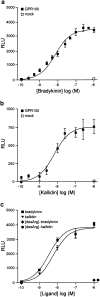Identification and characterisation of GPR100 as a novel human G-protein-coupled bradykinin receptor
- PMID: 14530218
- PMCID: PMC1574110
- DOI: 10.1038/sj.bjp.0705521
Identification and characterisation of GPR100 as a novel human G-protein-coupled bradykinin receptor
Abstract
G-protein-coupled receptor 100 (GPR100) was discovered by searching the human genome database for novel G-protein-coupled peptide receptors. Full-length GPR100 was amplified from a cDNA library of the neuroendocrine cell line BON, which is derived from a human pancreas carcinoid. The open-reading frame, present on a single exon, coded for a protein of 374 amino acids with highest sequence identity (43%) to the human orphan somatostatin- and angiotensin-like peptide receptor. The analysis of chromosomal localisation mapped the GPR100 gene to chromosome 1q21.2-q21.3. The stable expression of GPR100 in Chinese hamster ovary cells together with aequorin as calcium sensor and the promiscuous G-protein subunit alpha16 as signal transducer revealed bradykinin and kallidin as effectors to elicit a calcium response. Dose-response curves yielded EC50 values for both ligands in the low nanomolar range, while the respective analogues without arginine at the carboxy-terminus were inactive. Calcium mobilisation was inhibited by the phospholipase C blocker U73122, but not by pertussis toxin, suggesting the involvement of the G-protein subunit alphaq and not alphai or alphao in signal transduction. In line with the main function of kinins as peripheral hormones, we found that GPR100 was expressed predominantly in tissues like pancreas, heart, skeletal muscle, salivary gland, bladder, kidney, liver, placenta, stomach, jejunum, thyroid gland, ovary, and bone marrow, but smaller amounts were also detected in the brain and in cell lines derived from tumours of various origins.
Figures







References
-
- BLAUKAT A., DIKIC I. Activation of sphingosine kinase by the bradykinin B2 receptor and its implication in regulation of the ERK/MAP kinase pathway. Biol. Chem. 2001;382:135–139. - PubMed
-
- BOUHOUCHE A., BENOMAR A., BIROUK N., MULARONI A., MEGGOUH F., TASSIN J., GRID D., VANDENBERGHE A., YAHYAOUI M., CHKILI T., BRICE A., LEGUERN E. A locus for an axonal form of autosomal recessive Charcot–Marie–Tooth disease maps to chromosome 1q21.2–q21.3. Am. J. Hum. Genet. 1999;65:722–727. - PMC - PubMed
-
- CHUNG D.A., WADE S.M., FOWLER C.B., WOODS D.D., ABADA P.B., MOSBERG H.I., NEUBIG R.R. Mutagenesis and peptide analysis of the DRY motif in the alpha2A adrenergic receptor: evidence for alternate mechanisms in G protein-coupled receptors. Biochem. Biophys. Res. Commun. 2002;293:1233–1241. - PubMed
MeSH terms
Substances
LinkOut - more resources
Full Text Sources
Other Literature Sources
Molecular Biology Databases

